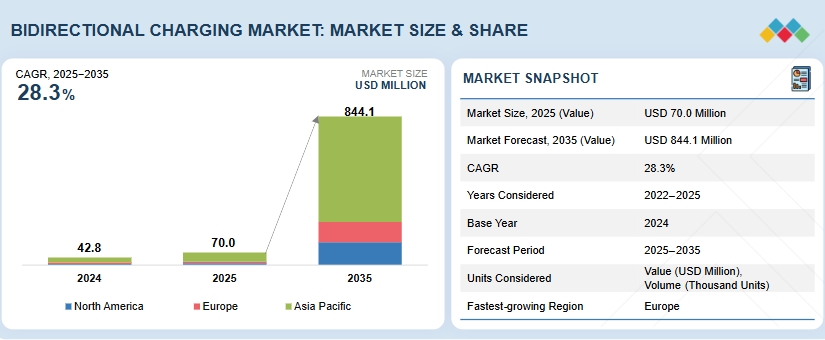The global market for bidirectional charging market is projected to grow from USD 70.0 million in 2025 to USD 844.1 million by 2035, at a CAGR of 28.3%.
The global bidirectional charging market is gaining strong traction, led by the widespread deployment of V2L features in passenger vehicles and growing V2H deployment for home energy backup. V2L has emerged as the most common use case, allowing users to power external devices easily and at low cost, while V2H is proving to be the most viable and valued application among luxury vehicle owners seeking energy backup and grid interaction.
Rapid advancements in ISO 15118-compliant bidirectional chargers are facilitating large-scale energy trading, peak load management, and advanced backup power solutions. Strategic collaborations of OEMs like Ford and Volkswagen with utilities are unlocking monetization pathways for fleets through demand response programs and energy arbitrage, while luxury brands leverage V2H functionalities to enhance premium user experiences and provide resilient home energy solutions.
“Battery electric vehicle is estimated to show a significant growth rate during the forecast period.”
Battery-run electric vehicles are expected to dominate the bidirectional charging market because their larger capacity allows them to supply significant power for applications like vehicle-to-home backup or vehicle-to-grid services, which is not feasible with smaller PHEV batteries. Automakers prioritize BEVs for bidirectional integration, as seen with Ford’s F-150 Lightning, which can power an entire home through its Intelligent Backup Power system, and General Motors’ Ultium-based EVs equipped with V2H capabilities.
Since BEVs operate entirely on electricity and come with larger batteries, they are best positioned to deliver meaningful power for applications such as vehicle-to-home backup and vehicle-to-grid services. Automakers are increasingly enabling these capabilities across their BEV portfolios. The Nissan Leaf was one of the earliest models to support V2G through projects with Fermata Energy, while Ford’s F-150 Lightning offers Intelligent Backup Power for home use. General Motors has also announced bidirectional support, starting with the Chevrolet Silverado EV, and plans to roll out the feature across Ultium-based BEVs in 2026. Hyundai’s Ioniq 5 and Volkswagen’s ID.4, which have updated software, also support V2H and V2G pilots, and Lucid Air provides vehicle-to-vehicle charging with its Wunderbox system.
Download PDF Brochure @ https://www.marketsandmarkets.com/pdfdownloadNew.asp?id=64700205
“AC bidirectional charging is estimated to account for the largest market in terms of charging type.”
The AC bidirectional charging segment is projected to account for the largest share of the market by charging type. This dominance is attributed to AC systems’ cost-effectiveness, ease of integration with existing residential electrical infrastructure, and scalability for small to medium-sized applications. AC charging leverages onboard vehicle chargers in V2L, reducing hardware complexity and installation costs, making it the preferred choice for mass-market adoption in home and light commercial environments. At the same time, V2H utilizes a home charger and additional components to change to AC power.
Several EVs are already compatible or are announced with AC bidirectional charging. GM has made many of its Ultium-platform vehicles V2H-enabled for model years 2024-2025 (e.g., Chevrolet Silverado EV, Blazer EV, Equinox EV) via the GM Energy V2H Bundle, and Tesla’s Cybertruck includes “Powershare,” an AC bidirectional system that delivers up to ~11.5 kW at 240 V for home backup or external loads. Other examples include the Cadillac Lyriq, Cadillac Escalade IQ, and Cadillac Optiq. These are either already V2H-capable or announced.
“Europe is projected to record the highest growth globally during the forecast period.”
Europe’s bidirectional charging market is strongly driven by key countries such as Germany, the UK, France, and Italy, each implementing supportive policies and pilot projects to foster adoption. Germany is a leader with regulatory reforms that treat bidirectional charging like stationary storage, enabling EVs to participate actively in the energy market and receive compensation. Initiatives like the BMW-E.ON V2G partnership and Volkswagen’s Elli pilot demonstrate practical commercial deployments integrating renewable energy and grid services. The UK is advancing through investments in smart grid infrastructure and V2G trials aimed at balancing supply and demand and reducing peak loads. At the same time, France focuses on fleet electrification and smart charging incentives to scale vehicle-to-grid integration. Italy’s growing EV uptake is supported by regional subsidies and utility collaborations that promote bidirectional technologies as part of broader energy transition strategies.
Key Players
The bidirectional charging market is dominated by established players such as Wallbox Chargers (Spain), NUVVE Holding Corp (US), Siemens (Germany), ABB (Switzerland), and Zaptec AS (Norway). These companies have the advantage of early bidirectional charger development, along with partnerships with OEMs for supplying compatible bidirectional chargers. These companies have set up R&D facilities and offer best-in-class products to their customers.
Request Free Sample Report @ https://www.marketsandmarkets.com/requestsampleNew.asp?id=64700205
Media Contact
Company Name: MarketsandMarkets™ Research Private Ltd.
Contact Person: Mr. Rohan Salgarkar
Email: Send Email
Phone: 18886006441
Address:1615 South Congress Ave. Suite 103, Delray Beach, FL 33445
City: Florida
State: Florida
Country: United States
Website: https://www.marketsandmarkets.com/Market-Reports/bidirectional-charging-market-64700205.html

